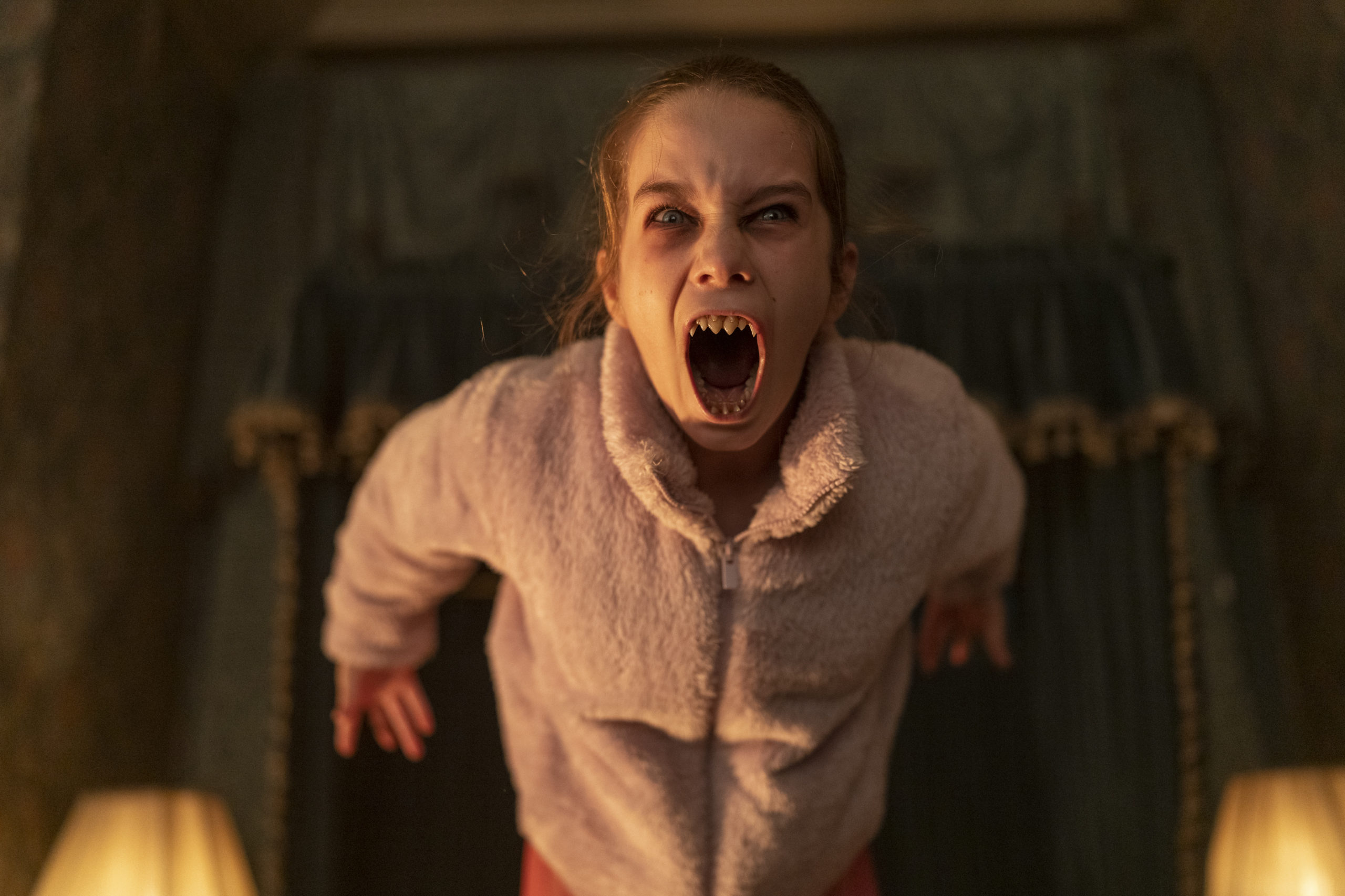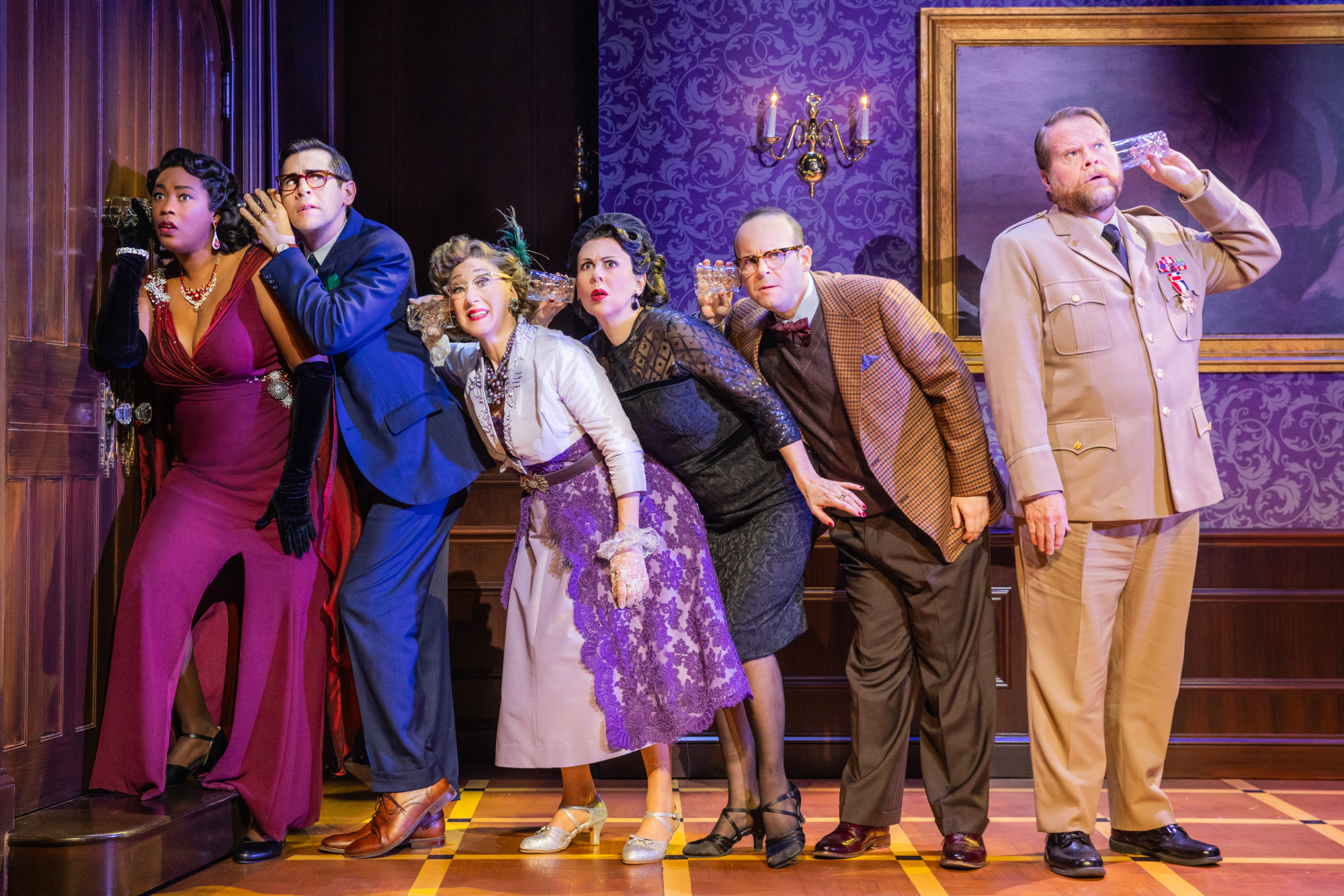Reviews
‘Abigail’ Review – Radio Silence Delivers Another Gory Good Time at the Movies

Abigail, the latest from directors Matt Bettinelli-Olpin and Tyler Gillett, feels like a spiritual sibling to their 2019 hit Ready or Not. Both are set almost entirely within a sprawling, warm-toned mansion and both deliver copious blood splatter to a delightfully satisfying degree. But Abigail is an inverse of Ready or Not; instead of one heroine targeted and preyed upon by a group of morally dubious enemies, it’s one vicious threat picking off morally dubious kidnappers one by one, slasher style.
While that may make for a more conventional watch with fewer surprises, Radio Silence’s ballerina vampire movie is a bloody blast all the same.
The heist-turned-vampire feature begins with the coordinated kidnapping of 12-year-old ballerina Abigail (Alisha Weir), the daughter of a powerful crime lord guaranteed to fetch a hefty ransom prize. Splitting the obscene loot are the six tasked with snatching Abigail from her home and safeguarding her for 24 hours: ex-cop Frank (Dan Stevens), medic and Abigail caretaker Joey (Melissa Barrera), endearing himbo muscleman Peter (Kevin Durand), spunky hacker Sammy (Kathryn Newton), wheelman Dean (the late Angus Cloud), and stoic ex-military gunman Rickles (William Catlett). The group of strangers arrive at their luxury hideout with minimal hiccups, where they’re given the rundown by employer Lambert (Giancarlo Esposito) and forced to give up their phones. Once left to their own devices, it quickly becomes clear that their kidnapping stint comes with job hazards they couldn’t have anticipated.

(from left) Dean (Angus Cloud), Sammy (Kathryn Newton), Abigail (Alisha Weir, back to camera), Peter (Kevin Durand), Frank (Dan Stevens, background), Joey (Melissa Barrera) and Rickles (Will Catlett) in Abigail, directed by Matt Bettinelli-Olpin & Tyler Gillett.
While the marketing for Abigail may have already revealed the precise threat that this code-named Rat Pack is dealing with, it actually takes a while for the unwitting kidnappers to discover the bloody truth. Bettinelli-Olpin and Gillett, working from a script by Guy Busick and Stephen Shields, relegate their murderous ballerina to the background for much of the first half to establish the group dynamics and stakes. That’s not a bad thing; Abigail boasts an ensemble cast that makes you want to spend time with them. Early scenes see the six feel each other out, test boundaries, and forge tenuous alliances in acerbically funny ways that make key exposition feel far less tedious than it would in lesser hands. More impressively, this game cast adds depth and pathos to their archetypical roles within the heist and horror.
Barrera’s Joey quickly emerges as the film’s antiheroine for her street smarts and boundless empathy, tasked with the role of the straight man. Joey keeps her cool, as much as possible, even when the horror kicks arrive in full. While Barrera makes easy work of instilling rooting interest and delivering some of the tougher bursts of exposition, she’s often upstaged by Stevens, having a clear blast playing the sleazy but savvy Frank. But Stevens isn’t the only scene-stealer here. Newton, especially through her scene partners, including Cloud, delivers some of the film’s funniest moments with her infectious charisma and witty line delivery. But it’s Durand’s loveable but dumb enforcer that threatens to steal it all, with Peter serving as the butt of many jokes to an unbelievably charming degree. And when Weir finally unleashes her inner monster, her ferocious yet layered portrayal easily establishes the young actor as a star on the rise.

(from left) Abigail (Alisha Weir) and Sammy (Kathryn Newton) in Abigail, directed by Matt Bettinelli-Olpin & Tyler Gillett.
It’s the cast and their memorable characters that carry Abigail far when the build-up adheres to familiar narrative beats. There’s a sense of awareness of the cinematic vampires that have paved the way, with Abigail acknowledging and borrowing from various aspects of the vampire mythos, but the film never attempts to reinvent the wheel. Instead, Abigail just wants you to have a good time seeing its unlucky criminals in over their heads in increasingly deranged and violent ways. Ultimately, a few unexpected narrative turns herald in one of the goriest finales to come along in quite some time: gorehounds, this one is definitely all for you.
The exquisitely detailed production design by Susie Cullen and a heaping helping of viscera and gore from the SFX team bolster a slick production (in more ways than one) that gives this enthusiastic cast plenty to sink their teeth into. Abigail is savagely inventive in terms of its vampiric gore, offering a thrill ride with sharp, pointy teeth. Though Abigail may be too methodical in its steady ramp-up toward full-blown insanity, the brilliant ensemble makes the journey worth it. With an insane commitment to arterial spray, Abigail winds up another crowd-pleaser from Bettinelli-Olpin and Gillett. It’s poised to deliver the most fun you’ll have at the movies this year.
Abigail releases in theaters on April 19, 2024.


Reviews
‘Clue: A New Comedy’ Stage Play Is a Slapstick Slasher That Lovingly Adapts Hasbro’s Board Game

The national tour of ‘Clue: A New Comedy’ remixes the classic murder mystery with farcical physical comedy and impassioned old-fashioned sensibilities.
“It’s all part of the game.”
There’s a strong relationship between mischievous murder mysteries and the horror genre. Murder mysteries inherently hinge upon death – it’s baked into the name – so it’s not surprising that horror has embraced this secretive subgenre and really emphasized the murder in murder mysteries. Murder mysteries have been popular in pop culture for nearly a century. However, there’s been a recent renaissance on this front with playful films like Knives Out, A Haunting in Venice, Bodies Bodies Bodies, the Scream franchise, and the prominence of the true-crime genre and armchair detectives. That being said, an underrated and evergreen source of murder mystery hijinks that’s entertained audiences for 75 years is Hasbro and Parker Brothers’ Clue.
Clue has experienced many permutations over the years, including Jonathan Lynn’s 1985 cult classic film and several stage adaptations. In a new dawn where board game and toy IP are at an all-time high, a new stage adaptation of Clue has been put together by Sandy Rustin, with additional material by Hunter Foster and Eric Price, and directed by Casey Hushion. Hushion’s Clue: A New Comedy, which is in the middle of a national tour, effortlessly harkens back to vaudevillian silliness and broad laughs, while it simultaneously explores darker genre impulses and intrigue. It’s the perfect way to nostalgically celebrate the ’80s movie, but also remind audiences why Hasbro’s upcoming cinematic remake is long overdue.
Hushion’s Clue is an adaptation of Lynn’s ‘85 film, but it still brings many original ideas and revisions to the table so that this doesn’t just feel like a stripped down version of the movie. Clue: A New Comedy finds immense pleasure in how it translates the game’s rules so that it functions as a faithful adaptation of the game and the feature film, while it also becomes a fun, fresh entity that’s a living hybrid of both. In Clue: A New Comedy, blackmail functions as the story’s central mystery, just as it does in the board game and cinematic adaptation. Each color-coded houseguest has terrible secrets that they don’t want getting out, which becomes the impetus for the growing body count.
Clue is a comedic character study and this stage play presents well-defined individuals who are easy to identify and connect with, despite their one-dimensional nature. Mr. Green (John Shartzer) is the cast’s real standout, but there’s not a single weak link among Clue’s eight central players. Clue’s best moments are the ones when the whole cast gets to bounce off of each other and revel in the group’s chaotic energy. The play’s ‘50s McCarthyism setting also adds an extra layer of mistrust, paranoia, and subterfuge to the equation that still feels timely in its own way. Farcical, broad wordplay – especially from John Treacy Egan’s Colonel Mustard – are a delight and reminiscent of an old-fashioned radio play when it comes to Clue’s jokes, timing, and dialogue.
Beyond Clue’s script lies some exceptional physical comedy, particularly from Shartzer’s Mr. Green. There are broad group reactions that play out in unison for mass comic effect, as well as lighting cues that brilliantly accentuate punchlines and become a solid running gag throughout the 90-minute show. There are playful movement exercises that are expertly choreographed and verge on interpretative dance. Clue adopts a real Scooby-Doo energy to the production, especially when it comes to its scene transitions. Clue even indulges in a “multiple door chase sequence” that taps into the right energy for this degree of slapstick. To this point, there’s an absolutely brilliant slow motion sequence that’s a highlight of the show and adeptly incorporated.
Clue’s characters are its secret weapon, but stellar production elements help elevate the stage play to something truly special. There’s really powerful set design by Lee Savage that evokes a creepy, cozy Haunted Mansion aesthetic that’s the right atmosphere for this murder mystery tale. Clever design decisions result in rotating walls and rooms that economically get the most out of the stage’s environment. Clumsy execution of these elements would quickly sink Clue and ruin its crescendoing quality. They’re seamlessly handled, as are Ryan O’Gara’s evocative lighting design and Michael Holland’s jauntily creepy musical cues. All these elements work together to make sure that Clue is as visually entertaining as it is well-acted and written.
Clue: A New Comedy goes all-in on its laughs. That being said, the play’s death scenes are actually creepy and immaculately orchestrated with all the finesse of peak genre cinema. There are genuine slasher vibes present that pulse through the show’s pervasive slapstick silliness. It’s a testament to the sheer artistry of craft in Clue that both of these extremes work as well as they do. Clue also shrewdly embraces the infamous multiple ending angle that helped give Lynn’s feature film a smart extra meta layer to its storytelling. It’s fun, different, and takes advantage of the medium of theater to great effect. It’s also the satisfying culmination of a story that gets progressively manic, unhinged, and verges on collapsing in on itself by the end – but in the best way possible. Clue pushes boundaries with tone and control like an expert puppet master.
Clue: A New Comedy hits all the right notes and succeeds as a breezy piece of theater that celebrates whodunit hijinks, broad buffoonery, and wicked wit. It’s Agatha Christie meets Frasier. Clue is a show that definitely prioritizes comedy over horror and suspense, but there’s enough style in this production to properly sell the production’s more evil impulses. It’s unlikely that anyone will be genuinely frightened, yet the play will still keep audiences on the edge of their seats and eagerly anticipate who’s responsible for Boddy Mansion’s copious corpses. Clue: A New Comedy is the best way to experience the Hasbro and Parker Brothers classic before its next cinematic adaptation proves that murder and mayhem aren’t just a game anymore.
Go to Broadway.org to see if ‘Clue: A New Comedy’ will be coming to your area.


Photo by Evan Zimmerman for MurphyMade













You must be logged in to post a comment.